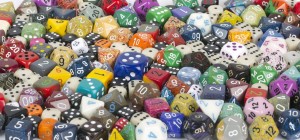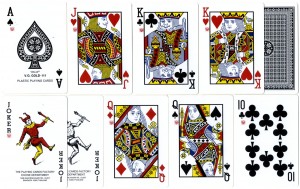
Last time we spoke, we covered some of the general reasons Deadlands is such a marvelous game and setting. Now we’re going to get down to the gritty specifics: a quick tutorial on how Deadlands works, and the things that set Deadlands apart. Since we’re still waiting for the release of the 20th anniversary edition, it’ll help to get some people up to speed on mechanics they might not be familiar with, or give a small refresher to cowpokes who’ve been away a bit.

Dice Pools
All your dice pools will be expressed as XdY. X is the number of dice you roll, Y is the die type. With two notable exceptions, you only take the highest die, although dice ‘explode’ in Deadlands. (Meaning if you get the maximum value, say a ‘6’ on a d6, you roll that die again and add six the new roll, potentially exploding again.) If the majority (over half) of your dice come up 1’s, you Go Bust, or fail catastrophically.
Attributes
You have two types of attributes in Deadlands. The first is your traits, akin to your basic ability scores in D&D. Each will be expressed like a die pool as above, and when you roll a raw trait score, that’s what you’ll roll. Humans have an upper limit of a d12 for trait scores, although the first number (the coordination value) theoretically has no upper limit.
You also have aptitudes. Each aptitude is attached to a trait, and will use the die type of the attached trait, while rolling a number of dice depending on the aptitude level. Aptitudes theoretically have no upper limit.

Fate Chips
The first mechanic Deadlands uses that might be new to you is fate chips, usually represented in most groups by colored poker chips. These chips come in limited quantities, with fifty of the least valuable white chips available, and only ten of the high value blue chips available. The most valuable, the legend chip, is only introduced after it is earned by performing particularly noteworthy deeds.
What are they for? First of all, their most frequent use is to negate combat damage. They allow you to ignore wounds or recover lost hit points (called wind), with the higher value chips providing greater protection. They also allow dice manipulation, with the smallest chips allowing you to roll an extra die, and the largest chips allowing you to reroll entire dice pools! There are a few rare supernatural powers that require the expenditure of fate chips, but their most coveted use is for bounty points. Fate chips can be cashed in for bounty, and these points used to purchase permanent character advancement. (The only way to do so.) Therefore, each fate chip expenditure becomes a risk: how badly do you need to succeed on that roll? Can you afford to take a little damage now so you’ll be able to buy up that aptitude score? It’s a careful balancing act, and one you’ll have to set the guidelines for yourself.
How do you earn them? Well, everyone gets thrown a bone at the beginning of a game session, and gets to draw three. You’ll also earn them for discovering clues, defeating bad guys, and progressing the story. However, the easiest way to earn them is with your hindrances. (Character flaws similar to Quirks/Drawbacks/Flaws in other systems.)

Cards
Standard decks of 54 playing cards (jokers included) are used for character generation (they replace die rolls to determine stats), combat initiative, and to determine the outcome of certain supernatural effects.
Like WoD, Twilight 2013, or Mayhem, Deadlands allows multiple actions per combat turn, which allows players who like ‘fast’ characters to actually see an advantage over one-woman, one-action systems. Having been dealt a varying number of cards based on an ability roll, initiative will count down from highest to lowest (suits are ordered to break ties). In an interesting twist, characters with the Leadership aptitude can ‘swap’ cards between willing players, making Deadlands one of the few game systems to make group command skills useful.
Edges/Hindrances
Deadlands allows players to purchase a series of advantages (Edges) with building points, and to earn extra points with disadvantages (Hindrances). While many of these edges are nifty (the Arcane Background edge is the only way to access certain supernatural powers, and in my opinion every first time player should buy both the Nerves o’ Steel and Brave edges), the real meat of this system lies in its hindrances.
Like every such system, you can choose to buy hindrances that will have minimal impact on you, or even help you in some way. However, if you do, you’ve already received all the benefit you’ll get from those hindrances. You see, the easiest way to earn fate chips is by getting screwed by your hindrances: minor inconveniences earn you small fate chips, but ones that put you in life threatening danger net you huge rewards. (Note that this occurs not when a hindrance comes into play, but when it actually impacts you in a negative way. If you have the Ferner hindrance, and someone makes an unkind comment which you respond to with a witty retort that causes everyone to laugh at them, you get nothing. If you get jeered out of a bar because of your accent, you should be compensated with a fate chip.) Therefore, it actually behooves you to take hindrances that will bite you in the keister on a regular basis.
Wounds/Wind
Unlike World of Darkness and Twilight 2013 with their wound systems, or D&D and Pendragon with their hit point systems, Deadlands has both. This might seem a little complicated at first, but it’s actually both intuitive and simple.
Wind (hit points) represents minor damage like dings and scrapes, plus trauma and fatigue. Loss of wind will break you, sending you into blissful unconsciousness or curling up into a ball. Wind recovers fairly easily.
Wounds are another story. They are divided up by hit location, and their loss will result in the impairment or loss of the associated limb, or death in the case of heads and torsos. Wounds take a significant amount of time to heal, so it’s best to bring someone with some supernatural healing capacity, although mundane healing is also possible in a significant way through the Medicine skill.
Conclusion
There are lots of fiddly, specific mechanics that will only matter to you depending on your character, but these are the big ones. Once you’ve given them a chance, you’ll find the signature mechanics that make Deadlands pop not only emphasize the western theme, but add some tools that are typically missing from the RPG repertoire.
Until next time, amigos.
Jim Stearns is a one-armed gunslinger from the swamps of Southern Illinois. In addition to the bi-weekly Ravenloft Corner at High Level Games, his mad scribblings can frequently be found in Quoth the Raven, as well as anthologies like Selfies from the End of the World and Fitting In, both by Mad Scientist Journal.
Images are the Properties of Pinnacle and are used under Fair Use. We love Deadlands, and want to support them. Go and buy their books.
*Note, all opinions are the opinions of their respective Authors and may not represent the opinion of the Editor or any other Author of Keep On the Heathlands.